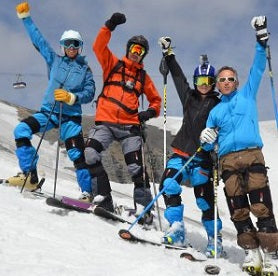
How to Ski With a Torn Meniscus

According to the American Academy of Orthopaedic Surgeons, meniscus tears are among the most common knee injuries. A torn meniscus occurs as a result of contact sports, during squatting or from twisting your knee. Your meniscus is a piece of cartilage that acts as a shock absorber, cushions your knee joint and helps to keep your knee stable. A meniscus tear can make physical activity -- including skiing -- uncomfortable and dangerous. You should not ski with a torn meniscus.
Step 1
Seek medical treatment. If you suspect a torn meniscus, discontinue skiing and visit with your physician. Symptoms of a meniscus tear include pain, swelling, weakness, stiffness and a lack of a full range of motion.
Step 2
Decide on a treatment option. You can treat a torn meniscus conservatively through rest, ice, compression and elevation. For more serious tears, you may need surgery.
Step 3
Participate in physical therapy. Focus on exercises that help to strengthen your knee as well as your entire leg. Straight leg raises, lunges, squats, hamstring stretches and quadriceps stretching can be performed.
Step 4
Engage in low impact exercise. With the permission of your doctor, low impact exercise can help you to stay in shape as you heal while placing very little stress on your affected knee. For your health and weight maintenance, the National Academy of Sports Medicine recommends 30 minutes of physical activity per day, five days per week. Consider swimming, riding a stationary bike or an elliptical machine.
Step 5
Ask your doctor about a knee brace to help stabilize your knee as you ski.
Step 6
Return to skiing with the permission of your doctor. Start out slow and progress to where you were before your injury. To avoid injuries, the National Academy of Sports Medicine recommends gradually increasing your routine by 10 percent weekly until you reach your full routine.
Warnings
If you experience pain while skiing, discontinue skiing and contact your doctor.
Related:
How To Choose One Best Type Of Knee Brace For Your Knee Pain?
- Choosing a selection results in a full page refresh.

1 comment
Christopher Nguyen
I tore my ACL and meniscus in high school playing soccer at the beginning of my senior year of high school. I had to watch my team win and make it all the way to the state championship game. Nothing was harder than not being able to contribute or take part. Back then I didn’t know too much about physical therapy and didn’t take it as seriously as I didn’t have much support from family during my recovery process. This took a toll on me physically and psychologically to the point where I didn’t play the game I loved for years.
Fast forward a couple years through college and post undergrad I still can’t play soccer confidently and my strikes are no where near as powerful as the were pre surgery. I’ve gone through so many braces, sleeves, kinesiology tape, you name it to find more support and comfort that it has just become exhausting and expensive. I still find mobility is an issue and during the game I am always doubting the stability within my knee. I feel I will always be a step under my past potential until i can feel comfortable that my knee has the support it needs.
After finding this site and reading all the success stories I would love to give bracelayer a try and finally find a product that works. Thanks!